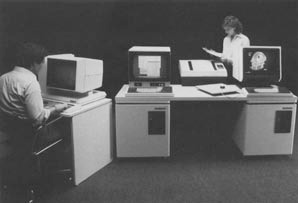Chapter 10: CAD/CAM/CADD/CAE
10.1 Introduction

As is the case with most of computer graphics, the Computer-Aided Design (CAD) discipline can trace its beginnings to the Sketchpad system developed by Ivan Sutherland in 1963. Sutherland was able to connect the display capabilities of the CRT, with the computational abilities of the computer, and the interactive process made possible with the light pen to create a system for designing mechanical parts. His system was described in a 1963 AFIPS conference paper. At the same conference, his advisor, Prof. Steven Coons of MIT published an article that laid out the relationship of the computer-aided design system as it evolved from the automatic programmed tool (APT) that was developed from the milling machine that was designed for use with the Whirlwind computer (both of these articles are referenced in the bibliography box at the end of this section.)
As was discussed in Chapter 2, the work of Sutherland prompted the automotive and aerospace companies to take notice and start their own projects to try to harness the power of the computer for their design needs. One of the most notable programs was the DAC (Design Augmented by Computer) project at General Motors (Chapter 3), which was a joint project with IBM. Two of the main individuals involved in this project were Fred Krull and Dr. Patrick Hanratty, whose contributions will be discussed later.

The late 60s saw a flurry of activity in the CAD-related sector. Besides the turnkey companies described below, several other companies started creating and marketing software or hardware for this industry. David Evans and Ivan Sutherland founded Evans and Sutherland Computer Corporation (E&S), which was one of the leaders in high end graphics workstations used in the CAD arena. Other equipment was developed by IBM, Adage, GE, DEC, CalComp and others (see Chapter 3.) One of the main players at this time was Calma, originally a manufacturer of digitizers used in mapping and integrated circuit manufacturing. (In the mid-80s Calma was acquired by General Electric and then sold to Prime Computer.)
On the software side, MAGI released its SynthaVision solids software, which is considered by many to be the first commercial solid modeler program. Charles Eastman, at the Institute for Physical Planning at Carnegie Mellon, developed the GLIDE system with Max Henrion and the General Space Planner (GSP) System, a software system for solving space planning problems. Eastman and Kevin Weiler also published a seminal paper on the use of Geometric Modeling Using the Euler Operators. Pierre Bezier and Steven Coons contributed important approaches to free-form surface applications for the CAD industry. The CSG modeler PADL-1 , and later PADL-2 were developed by the Production Automation Project at the University of Rochester. Bruce Baumgart introduced a data structure, called the Winged Edge data structure, that provided an efficient representation for 3D objects.
Pierre Bezier wrote of his remembrances of the early CAD activities in the IEEE Annals of the History of Computing in a 1998 issue.
Sutherland, Ivan, SKETCHPAD: A Man-Machine Graphical Communication System, AFIPS, SJCC 23 (1963), pp 329-346.
Coons, Steven, An Outline of the Requirements of a Computer-Aided Design System, AFIPS, SJCC 23 (1963), pp 299-304.|
Definitions:
CAD – computer-aided design
The use of computer programs and systems to design detailed two- or three-dimensional models of physical objects, such as mechanical parts, buildings, and molecules.
CAM – computer-aided manufacturing
The process of using specialized computers to control, monitor, and adjust tools and machinery in manufacturing.
CAE – computer-aided engineering
Use of computers to help with all phases of engineering design work. Like computer aided design, but also involving the conceptual and analytical design steps.
CADD – Computer Aided Drafting and Design, Computer-Aided Design & Drafting, or Computer-Aided Design Development
The use of the computer to help with the drafting of product plans.
– The American Heritage® Dictionary of the English Language, Fourth Edition
David Weisberg wrote an online book titled The Engineering Design Revolution – The People, Companies and Computer Systems That Changed Forever the Practice of Engineering
